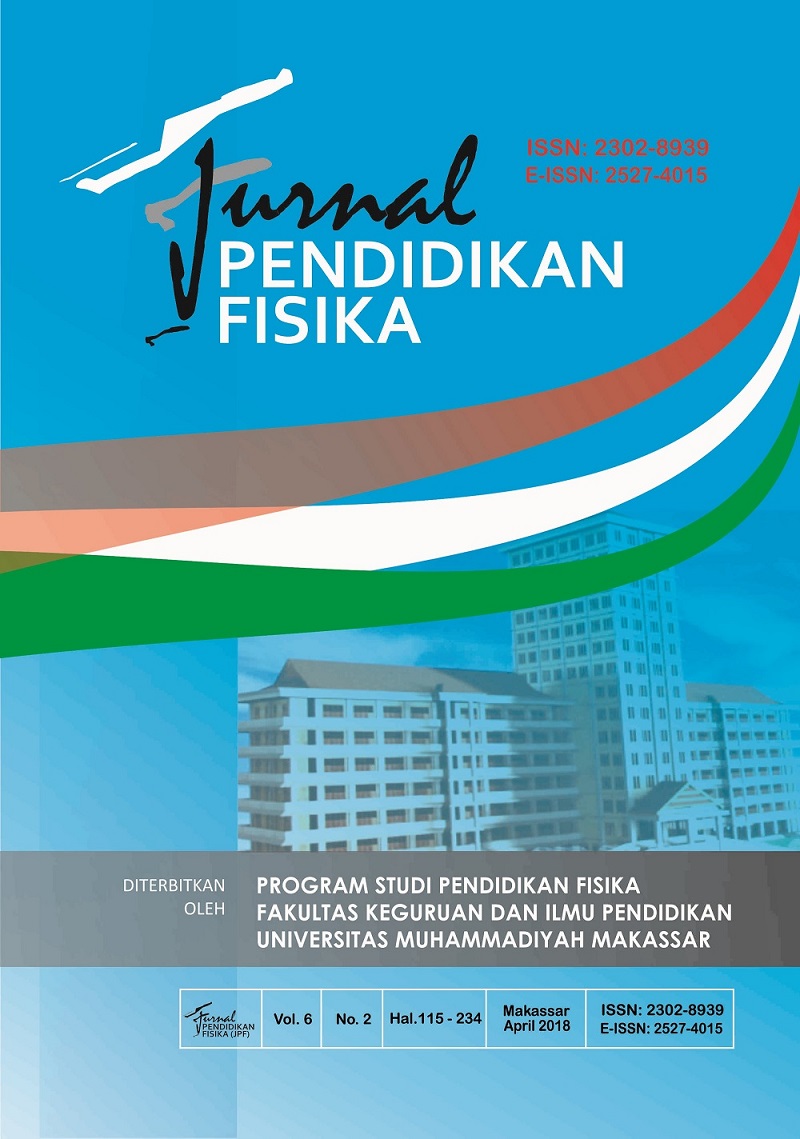Penerapan Pendekatan Saintifik dalam Pembelajaran Fisika terhadap Sikap Ilmiah Peserta Didik Kelas XI IPA 3 SMA Negeri 14 Makassar
DOI:
https://doi.org/10.26618/jpf.v6i2.1308Abstrak
Penelitian ini bertujuan untuk mendeskripsikan bagaimana sikap ilmiah peserta didik setelah diterapkan pendekatan saintifik. Jenis penilitian yang digunakan adalah penelitian pra eksperimen dengan desain one-shot case study. Populasi penelitian ini adalh seluruh kelas XI IPA SMA Negeri 14 Makassar. Pengambilan sampel penelitian ini diambil secara random sehingga diperoleh XI IPA 3. Instrument yang digunakan adalah angket sikap ilmiah dengan 3 indikator yaitu kritis, rasa ingin tahu dan terbuka/kerja sama, dimana instrumen telah di validasi oleh pakar. Angket terdiri dari 22 pernyataan yang mencakup 3 indikator, dengan pernyataan positif sebanyak 12 dan negativ 10 pernyataan. Penelitian menggunakan analisis deskriptif. Dalam penelitian ini, dianalisis kemampuan sikap ilmiah dengan mengelompokkan peserta didik dalam 4 kriteria yaitu sangat tinggi, tinggi, rendah dan sangat rendah, dengan persentase sangat tinggi sebesar 21,2%, tinggi 36,4%, rendah 27,3% dan sangat rendah 15,1% selanjutnya dianalisis berdasarkan indikator ketercapaian sikap ilmiah, sikap kritis sebesar 57,47%, terbuka dan kerja sama sebesar 69,16% dan yang tertinggi sikap rasa ingin tahu sebesar 74,85%. Dari hasil penelitian ini maka dapat disimpulkan bahwa sikap ilmiah peserta didik kelas XI IPA 3 SMA Negeri 14 Makassar yang diajar menggunakan pendekatan saintifik tergolong tinggi.
Kata kunci: Sikap Ilmiah, Penelitian pra eksperimen, Pendekatan Saintifik.
This study aims to describe how the scientific attitude of learners after applied scientific approach. Type of research used is pre experimental research with one-shot case study design. The population of this study is all the class XI IPA SMA 14 Makassar. Sampling of this research is taken randomly so that obtained XI IPA 3. Instrument used is questionnaire of scientific attitude with 3 indicator that is critical, curiosity and open / cooperation, where instrument has been validated by expert. Questionnaire consists of 22 statements covering 3 indicators, with positive statements of 12 and negativ 10 statements. The study used descriptive analysis. In this study, we analyzed the ability of scientific attitude by classifying the students in 4 criteria that is very high, high, low and very low, with very high percentage of 21.2%, high 36.4%, low 27.3% and very low 15,1% then analyzed based on indicators of scientific attitudes, critical attitude of 57.47%, open and cooperation equal to 69,16% and the highest curiosity attitude equal to 74,85%. From the results of this study it can be concluded that the scientific attitudes of students class XI IPA 3 SMA Negeri 14 Makassar who taught using a scientific approach is quite high
Key words: Scientific Attitudes, Pre experimental Research, Scientific ApproachReferensi
Hosnan, M. 2015. Pendekatan Saintifik Dan Kontekstual Dalam Pembelajaran Abad 21 Kunci Sukses Implementasi Kurikulum 2013.Jakarta: Ghalia Indonesia.
Kemendikbud. 2013. Konsep pendekatan saintifik dalam kurikulum 2013. Diklat Guru Online.Tersedia pada: http//www.akhmadsudrajat.files.wordpress.com /2013/.../pendekatan-saintifik-ilmiah.
Majid, Abdul., Rochman, Chaerul.2015. Pendekatan Ilmiah dalam Implementasi Kurikulum 2013. Bandung: PT Remaja Rosdakarya.
Sani, Ridwan Abdullah. 2015. Pembelajaran Saintifik Untuk Implementasi Kurikulum 2013. Jakarta: Bumu Aksara.
Arsa, Suka. 2015. Belajar Dan Pembelajaran. Yogyakarta: Media Akademi.
Astuti, R., W. Sunarno, & S. Sudarisman. 2013. Pembelajaran IPA dengan Pendekatan Keterampilan Proses Sains Menggunakan Metode Eksperimen Bebas Termodifikasi dan Eksperimen Terbimbing Ditinjau dari Sikap Ilmiah dan Motivasi Belajar Siswa. Jurnal Inkuiri, 1(1): 51-59. Tersedia di http://jurnal.pasca.uns.ac.id
Jufri, Wahab. 2016. Belajar dan Pembelajaran Sains. Mataram: Pustaka Reka Cipta.
Emzir.2015. Metodologi Penelitian Pendidikan Kuantitatif Dan kualitatif.Jakarta: Rajawali Pers.
Sugiono. 2012. Statistika Untuk Penelitian. Bandung: Alfabeta
Mardapi, Djemari. 2008. Teknik Penyusunan Instrumen Tes dan Nontes. Jogjakarta: Mitra Cendekia Press
Saregar, A. (2016). Pembelajaran Pengantar Fisika Kuantum dengan Memanfaatkan Media Phet Simulation dan LKM Melalui Pendekatan Saintifik: Dampak pada Minat dan Penguasaan Konsep Mahasiswa. Jurnal Ilmiah Pendidikan Fisika Al-Biruni, 5(1), 53. https://doi.org/10.24042/jpifalbiruni.v5i1.105
A.Machin. 2014. Implementasi Pendekatan Saintifik, Penanaman Karakter dan Konservasi pada Pembelajaran Materi Pertumbuhan. (Online), JPPI 3 (1) (2014) 28–35 (http://journal.unnes.ac.id /nju/index. php/jpii, diakses 10 Desember 2017).
Suadin, Didin., Khaeruddin & Nurlina. 2016. Upaya Meningkatkan Hasil Belajar Fisika melalui Pendekatan Scientific pada Peserta Didik Kelas VII/F SMP Negeri 1 Sungguminasa.Jurnal Pendidikan Fisika UNISMUH, Vol. 3, No. 3, 2302-8939.
Unduhan
Diterbitkan
Terbitan
Bagian
Lisensi
Copyright:
Authors who publish with this journal agree to the following terms:
1. Authors retain copyright and grant the journal right of first publication with the work simultaneously licensed under a Creative Commons Attribution-ShareAlike 4.0 International License that allows others to share the work with an acknowledgement of the work's authorship and initial publication in this journal.
2. Authors are able to enter into separate, additional contractual arrangements for the non-exclusive distribution of the journal's published version of the work (e.g., post it to an institutional repository or publish it in a book), with an acknowledgement of its initial publication in this journal.
3. Authors are permitted and encouraged to post their work online (e.g., in institutional repositories or on their website) prior to and during the submission process, as it can lead to productive exchanges, as well as earlier and greater citation of published work.
Licence:
Authors are free to:
1. Share: Copy and redistribute the material in any medium or format
2. Adapt: Remix, transform, and build upon the material for any purpose, even commercially.
The licensor cannot revoke these freedoms as long as the authors follow the license terms, which include the following:
1. Attribution: You must give appropriate credit, provide a link to the license, and indicate if changes were made. You may do so in any reasonable manner, but not in any way that suggests the licensor endorses you or your use.
2. ShareAlike: If you remix, transform, or build upon the material, you must distribute your contributions under the same license as the original.
3. No additional restrictions: You may not apply legal terms or technological measures that legally restrict others from doing anything the license permits.
Jurnal Pendidikan Fisika is licensed under a Creative Commons Attribution-ShareAlike 4.0 International License.

